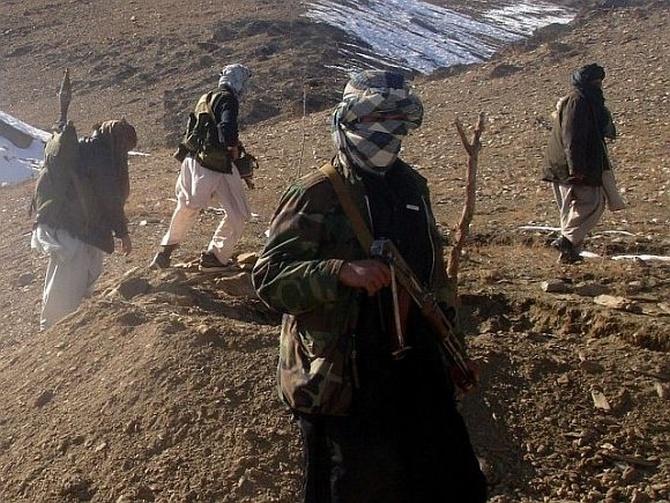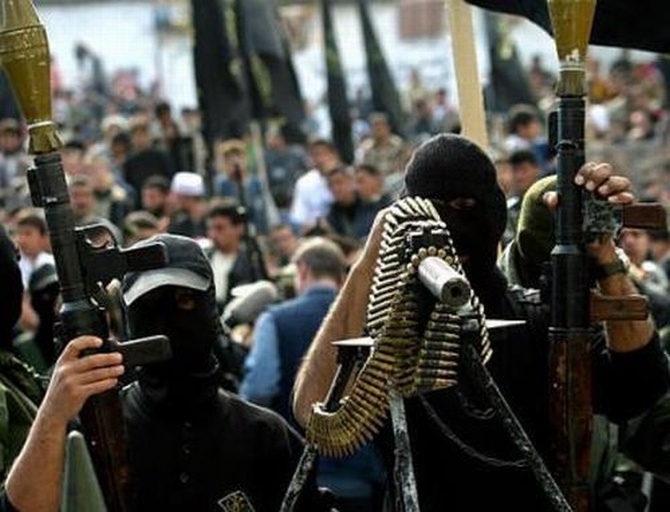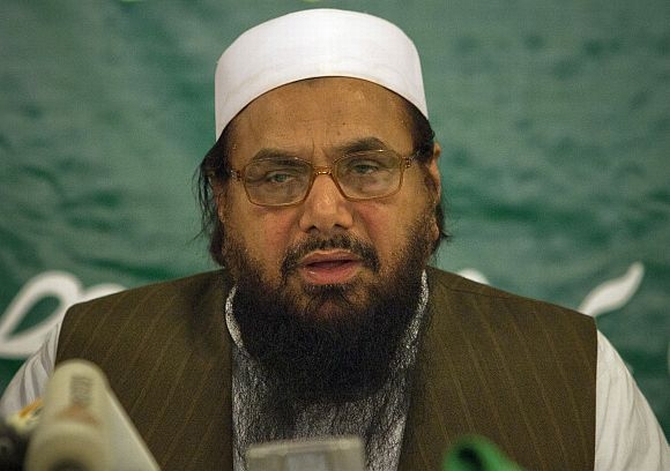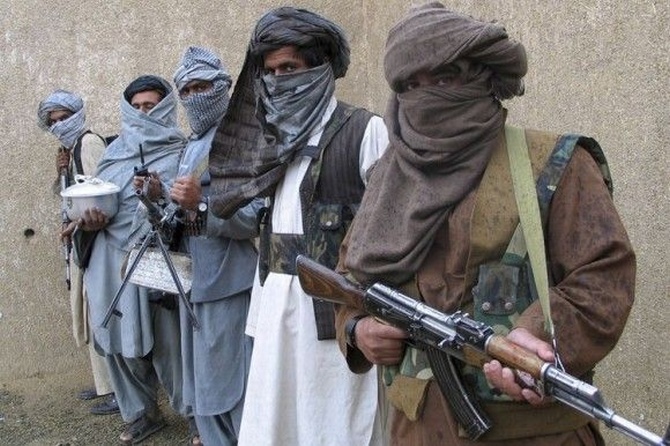
'Within 24 hours, Ajmal and Muzaffar had reached Lashkar's global headquarters in Muridke... Passing through a succession of checkpoints, they were frisked and relieved of their mobile phones...'
'Inside, they joined thirty more newcomers, all of them nervous and tired from long journeys across the Punjab, their possessions crammed into tin trunks...'
'One week in, they were introduced to Qahafa the Bull, chacha Zaki's number two, and from the start the boys were in awe of his fighting prowess. After evening prayers, Qahafa gathered the boys in the main mosque to hear stories of sacrifice and triumph, screening film of successful fidayeen attacks on Indian installations in Kashmir.'
A gripping account of how Lashkar-e-Tayiba recruits trained for its fidayeen attack on Mumbai five years ago. An exclusive excerpt from The Siege: The Attack on The Taj, by Adrian Levy and Cathy Scott-Clark.
A party of Lashkar trainee fighters bumped along in a hand-painted bus that spluttered and lurched into the wooded mountains of Pakistan-administered Kashmir. Qahafa the Bull, the mujahid trainer, and chacha Zaki, the outfit's military commander, had selected them from a much larger pool of recruits, and from this group they intended to choose the final ten-man team for Operation Bombay.
Arriving at the House of the Holy Warriors, on the bowl-like plains high above Muzaffarabad, the men were frisked for cigarettes, opium and tobacco, before being photographed and fingerprinted.
No one would be allowed to leave without an instructor for fear of contaminating the outfit, although none of them had any idea as to where they were being assigned.
Anxious and exhausted from the bone-breaking 350-mile journey, the trainees were shown to their canvas barracks, sixteen in each tent, each one issued with a number to replace his real name.
They would be allowed only one monitored phone call a week. Qahafa the Bull and his instructors regulated sleeping, eating, washing and praying. Chatting about home life was discouraged. All of them did it anyway.
One of the thirty-two was Ajmal Kasab, who had no idea that he was on the way to Mumbai.
Born in September 1987 in Faridkot, a scrawny village hugging the highway on the poverty-stricken far eastern fringes of the Punjab, Ajmal's neighbours eked out a living in a landscape dotted with shrines and long-forgotten ruins dating back to the Indus Valley Civilisation.
This was a historic recruiting ground, with many levies drawn from here by the British, and for centuries before them by warring princes. But Partition had sent the Hindu and Sikh residents fleeing to India, while their homes were taken over by Muslim refugees, who barricaded themselves inside brick compounds to endure Pakistan's Year Zero.
Physically closer to India than to any of the Punjab's great cities, villagers were raised on stories of loss, and grew up despising their looming neighbour. The mosque was the only communal meeting point.
Chacha Zaki, who came from Okara, Faridkot's nearest city, twenty miles away, had left the district to fight in the secret Afghan war of the 1980s, as did hundreds of thousands of others from the Punjab.
Afterwards, he had joined up with a lecturer at Lahore's University of Engineering, Hafiz Saeed, who spun emotive stories of his family having lost thirty-six relatives during the Partition slaughter.
In 1990, the fighter and the lecturer (who was also a cleric) formed Lashkar-e-Tayiba to spread a message that those who fled and their descendants could take revenge by destroying India, piece by piece. They fed off the anger, destitution and sense of dislocation that permeated every household.
Extracted with the publisher's permission from The Siege: The Attack on The Taj by Adrian Levy and Cathy Scott-Clark by Penguin Books India, Rs 499.
Kindly ...

In Faridkot, Ajmal and his four siblings lived behind a turquoise tin door. The main street was a sump, strung with petrol pumps and mechanical repair shops that serviced passing trade.
Once the family had been goat herders and later they had sold meat, giving them their surname, which loosely translated as 'butcher'. But the Kasabs had fallen on hard times and Ajmal's father laboured 150 miles away on the building sites of Lahore, earning 400 rupees a week.
The family home had no toilet or electricity. They drew their water from a communal tap, threw their rubbish over the wall and slept nose-to-toe in the room where they ate, lit by a single kerosene lamp.
The home was ruled by Ajmal's mother, Noor Elahi, who fell pregnant during her husband's occasional visits, but otherwise lived a covered life inside the family compound. With his father absent, Ajmal, the second son, a boy whose name in Arabic meant 'the handsome one' was rebellious.
Short and muscly, he grew his hair long, chewed tobacco and hung out at Faridkot's bus stand. But the district was changing, its mood lifting, mainly through the success of Lashkar, which had made its reputation taking on one of the largest security establishments in the world in Indian-administered Kashmir, supporting an insurgency that had exploded there in 1989.
Forlorn Okara sent so many soldiers on jihad it became feted as a 'blessed city' and Lashkar made sure everyone heard the message: Free literature handed out after Friday prayers, the health checks conducted by Lashkar-sponsored doctors, lavish tamashas hosted for every shaheed, or martyr.
Lashkar volunteers would shower the community with sweets and his family with compensation before the deceased's testament was read aloud like a battle citation.
Dying for jihad in Kashmir was the highest accolade one could strive for in a bitter landscape where the alternative was living for nothing and it brought respect and dignity to families who previously had none.
Visiting commanders toured like pop idols. Posters of martyrs were pinned in doorways in Okara, where in other cities one would see Bollywood movie posters. Collection boxes filled up in the grocer shop. Graffiti dominated every village wall: 'Go for jihad. Go for jihad.' Others attested to the new world order: 'Neither cricket stars nor movie stars, but Islamic mujahideen.'
Teenagers like Ajmal read stirring youth publications printed by Lashkar's media wing, which liberally used the testimonies of slain fighters to solicit new recruits, even penning a cartoon strip in one, which children nicknamed Shaheed Joe.
The outfit knew what it was doing. 'Children are like clean blackboards,' declared a Lashkar provincial chief. 'Whatever you write will leave a mark on them forever.'
Ajmal's turning point came in 1999, the year Pakistan and India went to war in the Kashmir heights at Kargil and his father Amir came home from Lahore sick with TB. From now on, Amir would earn about half of his construction wage, around 250 rupees a week, wheeling a handcart laden with fried snacks around Faridkot's dusty square. He fought with his son, whom he expected to make up his loss, eventually sending the thirteen-year-old to work as a labourer in Lahore.
Up at 4 am, washing in public toilets, Ajmal grew bitter and exhausted, his ambition blunted, his fear and loneliness pricked at night. He missed his mother and resented his vicious father.
After six backbreaking years in the building trade, Ajmal met a cocky youth who worked for the Welcome Tent Service, a catering business based in Jhelum, a city on the road to Islamabad. He was recruiting cooks, and offering hot food, safety and more money.
The hungry Ajmal moved to Jhelum and made a new friend, Muzaffar, whose name meant 'victorious'. He had his own ideas about surviving. Rolling rotis by day, he took Ajmal prowling at night, encouraging the smaller teenager to wriggle through bathroom windows, breaking into homes and offices.
Extracted with the publisher's permission from The Siege: The Attack on The Taj by Adrian Levy and Cathy Scott-Clark by Penguin Books India, Rs 499.
Kindly ...

With money in their pockets, Ajmal and Muzaffar went to the cinema and watched multiple showings of Sholay, a high-octane Bollywood thriller in which a veteran cop recruits two thieves, one of them played by Amitabh Bachchan, to catch one of their own.
In November 2007, they headed for Pakistan's cantonment city of Rawalpindi to buy a gun, hoping to become fully fledged hoods.
The city was buzzing with a carnival-like atmosphere. Elections were coming, Benazir Bhutto was back in town after an absence of almost a decade and the streets with filled with festive shamianas and fairground rides in preparation for Eid.
Wandering around the tents, Ajmal and Muzaffar met an elderly man, who bought them tea and persuaded them to visit the local Lashkar recruiting office. They were welcomed like long-forgotten relatives with plates of rice and mutton.
"They asked us our names, telling us to come the next day with our clothes and supplies." When one of the men in the office wrote 'Daura- e-Sufa' on a chit, telling them to travel to an address in Muridke outside Lahore, they readily agreed. Ajmal could barely read but with those few pen strokes, they had, without realising it, enlisted on a two-week Lashkar conversion course.
Within twenty-four hours, Ajmal and Muzaffar had reached Lashkar's global headquarters in Muridke, thirty minutes outside Lahore, a place called Markaz-e-Taiba -- the Centre of the Pure. Passing through a succession of checkpoints, they were frisked and relieved of their mobile phones.
Inside, they joined thirty more newcomers, all of them nervous and tired from long journeys across the Punjab, their possessions crammed into tin trunks.
A vast site, the Centre of the Pure resembled an expensive private university. There were broad roads and flower-lined pathways, playing fields, gardens, classrooms and an enormous concrete swimming pool, close to the back gate.
The grandest building was the Abu Harrera mosque, which could hold 5,000 and whose parade ground outside was strung with electric fans to keep the observants cool. There was even a girls's school, something that surprised village boys whose sisters never left the family home until the day they married.
The second day they were woken at 4 am, and the programme began with prayers, the first words in a religious immersion course. Unlike other groups that sent mercenaries into battle without any indoctrination, but who fought anyone declared as an enemy of the Muslim community, Lashkar rebuilt its recruits in its image to operate under strict religious, political and ideological guidelines.
"We were first converted from Sunni to Ahl-e-Hadith and we were taught the methods of the Hadeethis," Ajmal recalled.
At first, he struggled. ";Everything from namaz (prayer) to lunch to dinner happened with clockwork precision," he said. "The trainers were very strict."
He preferred the afternoons, when they played cricket, a game that since early childhood had enabled Ajmal to vent his hatred and anger towards India.
In these dusty matches on the Muridke grounds, Pakistan was always the winner.
One week in, they were introduced to Qahafa the Bull, chacha Zaki's number two, and from the start the boys were in awe of his fighting prowess. After evening prayers, Qahafa gathered the boys in the main mosque to hear stories of sacrifice and triumph, screening film of successful fidayeen attacks on Indian installations in Kashmir.
Qahafa and his trainers continuously distinguished between fidayeen and suicide missions. The latter were unthinkable. 'Suicide is to kill oneself in desperation after one fails to achieve that goal which has been set,' Ajmal was told.
A fidayeen squad 'died trying to achieve a virtuous goal'. They fought to win, and if they died that was a victory, too.
Extracted with the publisher's permission from The Siege: The Attack on The Taj by Adrian Levy and Cathy Scott-Clark by Penguin Books India, Rs 499.
Kindly ...

Finally, chacha Zaki arrived, driven into the campus in a Toyota pickup packed with armed guards, dressed in his trademark Afghan pakul cap and raw woollen shawl.
It was many years since Lakhvi had fought the Soviets, his prominent belly and the zabiba (prayer bump) on his forehead signalling that he spent more time these days in the mosque.
Lakhvi welcomed the new recruits and introduced them to a roster of instructors led by Al-Qama. Originally from Bahawalpur, in the southern Punjab, his real name was Mazhar Iqbal, and until recently he had run Lashkar's Kashmir operation.
From now on trainers like Qahafa and Al-Qama would become father figures to the boys, as they gradually relinquished ties with their real families.
Al-Qama had news. He revealed that he was looking to assemble a special team for a secret operation: 'We are readying to attack big cities in India. We shall start a war from within so that India is hollowed out.'
The recruits were electrified and terrified. Soon after, the outfit's amir, Hafiz Saeed, arrived in a convoy of saloon cars, protected by armed outriders. The students listened to his message.
Plucking his red beard before resting his hands across his chest as if he were praying, the amir delivered a ponderous eulogy about duty and bravery. He rounded off with a pledge that Ajmal would never forget.
'If you die waging jihad,' the amir said, inspecting the recruits, 'your faces will glow like the moon. Your bodies will emanate scent. And you will go to paradise.'
Chacha Zaki stepped forward to drum it home: 'You are Muslims. India is not humanity. They have left you in poverty and they are ahead of you.' Be ready, he told them. 'Your time is coming.'
From being nonentities the recruits were suddenly 'somebodies'. By February 2008, the group had shrunk to twenty-four boys, including Ajmal and Muzaffar. They were driven eight hours to the north-west, and the town of Mansehra, in the snowy hills of what was then Pakistan's North West Frontier Province.
Hidden here was another Lashkar training facility, just north of the Pakistan Military Academy and the town of Abbottabad, where Osama bin Laden would be killed four years later.
From the Mansehra bus stand they hiked up into the hills, carrying boots and a blanket, reaching a track that eventually led to Battal, a stone and wood village.
If Muridke had been scholarly, Battal was backbreaking. Motivational songs blasted from loudspeakers strung in the trees and during the twenty-one-day Daura-e-Aama (General Session), the recruits got to hold their first AK-47, or 'Kalashan'.
They also tackled a numbing obstacle course, crawling through icy pits, and what Ajmal lacked in stature, at barely 5 feet 3 inches, he made up for in sinewy determination, the trainers noted.
With basic training completed, the boys were ordered to take a break. What lay ahead was the Daura-e-Khasa (Special Session) that lasted two-and-a-half months and took place in the House of the Holy Warriors, in Pakistani-administered Kashmir.
As it cost Lashkar 1,000 pounds per fighter to graduate them, the outfit had to be sure about every candidate it put forward. At the end of it, Al-Qama would make his selection for the secret mission.
Muzaffar's family came to collect him. No one came from Faridkot for Ajmal, even though he was homesick. He called his mother, but the line was down. He was forced to remain at the Lashkar offices, mentoring new recruits, until the list went up for the boys accepted to commence the Special Session. Ajmal's name was on it, but Muzaffar's was not.
Extracted with the publisher's permission from The Siege: The Attack on The Taj by Adrian Levy and Cathy Scott-Clark by Penguin Books India, Rs 499.
Kindly ...

Poor and semi-orphaned boys, who had been made to feel like Special Forces by Lashkar, pitched their tents high in the Chelabandi hills, above Muzaffarabad, where Sajid Mir, Lashkar's foreign operations deputy, had his Ice Box.
Ajmal gravitated to another recruit, Hafiz Arshad. A muscly six- footer, Arshad was originally from Multan, in the southern Punjab. His family had handed him over to an Islamic seminary as they already had enough children working in the sugar cane fields.
Arshad only had one skill, which explained his first name: He was a hafiz, a rote learner of the Koran. But by the time he was a teenager, he knew nothing of Pakistan or what lay beyond it.
He became a labourer on the railways until he was handed a flyer advertising a public rally given by amir Hafiz Saeed.
The next to wander over was Shoaib, the youngest recruit. He had been born in the far north-eastern corner of the Punjab, in Barapind village, Sialkot district, which had been shelled during the Indo-Pak wars of 1965 and 1971, and he could see the mountains of disputed Kashmir from his home.
His father was a long-bearded lay preacher famous for championing the Ahl-e-Hadith cause. Shoaib had dropped out of school even younger than Ajmal, and signed up in his teens for training at Muridke, hoping 'to make India bleed'.
By the end of the first evening, there was a fourth member of their band, Naseer Ahmed, a self-declared 'skinny runt from Faisalabad'. Coming from the Punjab's second-largest city, he was more self-assured than the rest.
Naseer lived in a lane close to the city's famous Masjid Mubarik Ahl-e-Hadith, a Lashkar-supporting mosque, north-east of the city centre. Around the mosque, shops openly displayed fundraising boxes for Lashkar's charity wing and its functionaries were local celebrities.
Naseer had got swept along, working for Lashkar from an early age, recruiting poor boys from remote villages. Despite his slim frame and reedy voice, he was brave and fearless.
Ajmal, Hafiz, Shoaib and Naseer knuckled down. When the gruelling course neared its end they were told to assemble on a parade ground. A tall, slim, clean-shaven army officer was waiting for them. He looked out of place among the beards and pyjamas, but amir Saeed and chacha Zaki embraced him and Al-Qama introduced him: 'This is a Major General Sahib and we people are his men only.'
No one baulked. Everyone knew there were many Pakistani army officers in Lashkar. A colonel who claimed to have left in 2005 openly ran the organisation's information department. Some were disaffected soldiers who believed the military no longer had the liberation of Kashmir in its sights. Others believed the army was appeasing the enemies of Islam.
Most of these military men referred to themselves as retired. Whether they were or not, only they knew. Lashkar was a tangled ball of wool, creating cover for the machinations of the deep State.
The Major General Sahib . They role-played hostage taking, and were taught how to interrogate captives.
Everything hinged on the final test: Three days without food, water or maps in the woods, hunted by the instructors. Ten recruits ran away.
But when Ajmal, Hafiz, Shoaib and Naseer emerged, emaciated and frozen, they were feted by Al-Qama. They received a goat, a knife and a matchbox, and were told to prepare their own graduation meal.
Extracted with the publisher's permission from The Siege: The Attack on The Taj by Adrian Levy and Cathy Scott-Clark by Penguin Books India, Rs 499.